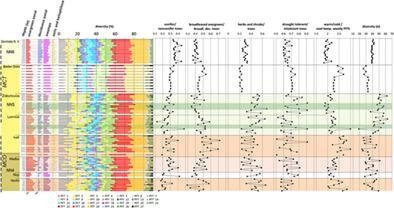当前位置:
X-MOL 学术
›
Geolog. J.
›
论文详情
Our official English website, www.x-mol.net, welcomes your feedback! (Note: you will need to create a separate account there.)
Vegetation and climate changes during the Miocene climatic optimum and Miocene climatic transition in the northwestern part of Central Paratethys
Geological Journal ( IF 1.8 ) Pub Date : 2020-12-13 , DOI: 10.1002/gj.4056 Nela Doláková 1 , Marianna Kováčová 2 , Torsten Utescher 3, 4
Geological Journal ( IF 1.8 ) Pub Date : 2020-12-13 , DOI: 10.1002/gj.4056 Nela Doláková 1 , Marianna Kováčová 2 , Torsten Utescher 3, 4
Affiliation

|
The study of pollen spectra mirrors the evolution of landscape and climatic changes in the northwestern part of Central Paratethys domain during the regional stages Karpatian–Badenian (Late Burdigalian–Langhian to Early Serravalian; NN4‐NN6 biozone). This interval includes the Miocene climatic optimum (MCO) and the Miocene climatic transition (MCT) at 14.8–12.0 Ma. Here we study the pollen record from marine strata in eight wells and sections (Hevlín, Slup, Medlov, Iváň, Lomnice, Židlochovice, Baden Soos, and Devínska Nová Ves) including a total of 92 samples. The standard pollen diagrams are simultaneously analysed using the Palaeotropical/Arctotertiary concept (P/A), synthesized diagrams, coexistence approach, and a technique allowing to reconstruct diversity of plant functional types in order to unravel climate changes and their impact on the biosphere. Warmest climate conditions supporting a diverse, thermophilous mixed mesophytic forest vegetation with a high proportion of broadleaved evergreen PFTs persisted in the neighbouring continental parts during the Karpatian to Early Badenian (NN4‐NN5 biozone) representing the MCO. Evidence for the MTC and subsequent cooling (NN5 and NN6 at ca. 14 Ma) comes from lower percentages of thermophilous and evergreen elements and higher diversity of deciduous PFTs in the ecospectra (Devínska Nová Ves, NN6 biozone). Inferred annual precipitation rates above 800 mm and the almost continuous presence subtropical swamp tree pollen point to the persistence of overall humid climate conditions in the study area. Reconstructed precipitation data and the presence of drought‐tolerant plant functional types (PFTs) point to a seasonal climate. The studied records partly show shorter term cyclic changes in climate and plant diversity related to glacial events in the Langhian. Using the proportion of broadleaved evergreen versus broadleaved deciduous tree diversity as indicator for temperature changes, several alternations of warmer and cooler phases are obvious from the record. Moreover, sedimentary facies plays an important role for quality and resolution of terrestrial signals in marine strata.
中文翻译:

中中地西北部的中新世最佳气候和中新世气候过渡期间的植被和气候变化
花粉光谱的研究反映了Karpatian–Badenian(晚期Burdigalian–Langhian至Serravalian早期; NN4-NN6生物区)区域阶段中部Paratethys区域西北部景观的演变和气候变化。这个间隔包括中新世气候最佳值(MCO)和14.8-12.0 Ma的中新世气候转变值(MCT)。在这里,我们研究了八口井和部分(Hevlín,Slup,Medlov,Iváň,Lomnice,Židlochovice,Baden Soos和DevínskaNováVes)海相地层的花粉记录,包括总共92个样本。使用古热带/建筑学概念(P / A),综合图,共存方法同时分析标准花粉图 以及一种技术,可以重建植物功能类型的多样性,以揭示气候变化及其对生物圈的影响。在代表MCO的Karpatian到Badenian早期(NN4-NN5生物区)的邻近大陆部分,最温暖的气候条件支持着多种多样的,嗜热的混合中生森林植被以及高比例的阔叶常绿PFT。MTC和随后的冷却(NN5和NN6在约14 Ma处)的证据来自生态光谱中较低的嗜热和常绿元素百分比以及落叶PFT的多样性(DevínskaNováVes,NN6生物区)。推断的800毫米以上的年降水率和几乎连续存在的亚热带沼泽树花粉表明研究区域总体湿润气候条件持续存在。重建的降水数据和耐旱植物功能类型(PFT)的存在表明了季节性气候。研究记录部分显示了与朗格冰川事件有关的气候和植物多样性的短期周期性变化。使用阔叶常绿与阔叶落叶乔木多样性的比例作为温度变化的指标,从记录中可以明显看出,暖和冷阶段的几种交替。此外,沉积相对于海相地层信号的质量和分辨率起着重要作用。使用阔叶常绿与阔叶落叶乔木多样性的比例作为温度变化的指标,从记录中可以明显看出,暖和冷阶段的几种交替。此外,沉积相对于海相地层信号的质量和分辨率起着重要作用。使用阔叶常绿与阔叶落叶乔木多样性的比例作为温度变化的指标,从记录中可以明显看出,暖和冷阶段的几种交替。此外,沉积相对于海相地层信号的质量和分辨率起着重要作用。
更新日期:2021-02-02
中文翻译:

中中地西北部的中新世最佳气候和中新世气候过渡期间的植被和气候变化
花粉光谱的研究反映了Karpatian–Badenian(晚期Burdigalian–Langhian至Serravalian早期; NN4-NN6生物区)区域阶段中部Paratethys区域西北部景观的演变和气候变化。这个间隔包括中新世气候最佳值(MCO)和14.8-12.0 Ma的中新世气候转变值(MCT)。在这里,我们研究了八口井和部分(Hevlín,Slup,Medlov,Iváň,Lomnice,Židlochovice,Baden Soos和DevínskaNováVes)海相地层的花粉记录,包括总共92个样本。使用古热带/建筑学概念(P / A),综合图,共存方法同时分析标准花粉图 以及一种技术,可以重建植物功能类型的多样性,以揭示气候变化及其对生物圈的影响。在代表MCO的Karpatian到Badenian早期(NN4-NN5生物区)的邻近大陆部分,最温暖的气候条件支持着多种多样的,嗜热的混合中生森林植被以及高比例的阔叶常绿PFT。MTC和随后的冷却(NN5和NN6在约14 Ma处)的证据来自生态光谱中较低的嗜热和常绿元素百分比以及落叶PFT的多样性(DevínskaNováVes,NN6生物区)。推断的800毫米以上的年降水率和几乎连续存在的亚热带沼泽树花粉表明研究区域总体湿润气候条件持续存在。重建的降水数据和耐旱植物功能类型(PFT)的存在表明了季节性气候。研究记录部分显示了与朗格冰川事件有关的气候和植物多样性的短期周期性变化。使用阔叶常绿与阔叶落叶乔木多样性的比例作为温度变化的指标,从记录中可以明显看出,暖和冷阶段的几种交替。此外,沉积相对于海相地层信号的质量和分辨率起着重要作用。使用阔叶常绿与阔叶落叶乔木多样性的比例作为温度变化的指标,从记录中可以明显看出,暖和冷阶段的几种交替。此外,沉积相对于海相地层信号的质量和分辨率起着重要作用。使用阔叶常绿与阔叶落叶乔木多样性的比例作为温度变化的指标,从记录中可以明显看出,暖和冷阶段的几种交替。此外,沉积相对于海相地层信号的质量和分辨率起着重要作用。


























 京公网安备 11010802027423号
京公网安备 11010802027423号